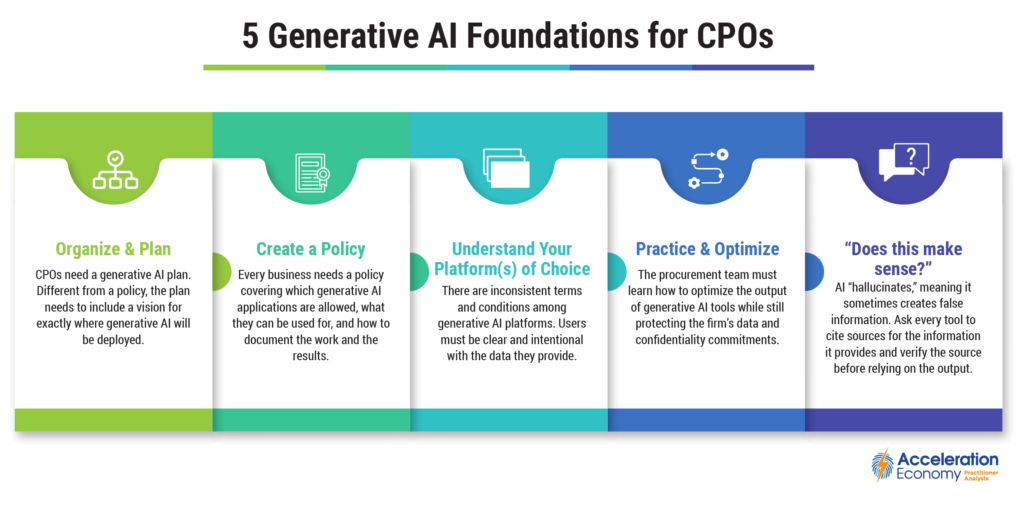Over the last few months, I’ve been experimenting with using generative AI (GenAI) to perform some basic procurement functions. There is real promise here in areas including supplier selection, RFP generation, risk mitigation, contract development, and other procurement tasks. Yet, when I presented some results at a recent conference, many participants reported that their companies forbade the use of ChatGPT or similar tools.
There certainly are risks with proprietary information getting out into the public domain, or confidentiality agreements being breached. But the opportunity is too good to pass up. So, here are some foundational tips for the enterprising Chief Procurement Officer (CPO) who wants to lead a team into taking advantage of these new tools.

Foundational Generative AI Tips
1. Organize
CPOs need a GenAI plan. Different from a policy, the plan needs to include a vision for exactly where GenAI will be deployed. There may be hundreds of possible use cases, but an assessment of pain points in the current procurement process will help target where to start.
For example, to mitigate risk, a procurement team in a company with a lot of offshore processes may want to start identifying suppliers in a different part of the world than they are currently operating. Another firm may need help developing new, or assessing current, supplier contracts. A third may be challenged finding suppliers for an innovative new product under development.
A free-for-all approach where everyone is doing their own thing will result in a lack of critical mass and will reduce the amount of learning from the journey to GenAI. Better to start by focusing GenAI experiments on a challenging business problem, learning from it, and using the knowledge as a springboard to other work.
And finally, data: If every user in the procurement team understands and follows a consistent data definition, results will be more robust and actionable.
2. Create a Policy
People don’t overtly go out and put their business at risk. But GenAI is so new that it is unlikely that anyone on the procurement team is well-versed enough to do it all the right way. So, every business needs a policy covering which GenAI applications are allowed, what they can be used for, and how to document the work and the results.
Many corporate policies have been developed and remain static for years. GenAI technology is changing so fast that the policy needs to be reviewed and updated frequently to stay relevant.
3. Understand Your Platform(s) of Choice
According to a Cooley Go article, there are inconsistent terms and conditions among GenAI platforms, so CPOs shouldn’t assume that what they know about one is applicable to others.
GenAI applications typically have the right to re-use or publish users’ information. Since the machine learning component of GenAI aims to have the results improve over time, that improvement is based on the collective information that is fed into it. That means there’s no way to protect your specific data. There is nothing to stop the GenAI tools from providing exactly the same output to multiple users. So, users must be clear and intentional with the data they provide.
4. Practice
Employing GenAI requires the procurement professional to make some process changes. For example, we are accustomed to providing detailed specifications to suppliers, information that is likely proprietary to our firms. In the search for a new supplier, members of the procurement team may be tempted to load that information into the AI tool they are using for the search.
Discover how AI has created a new ecosystem of partnerships with a fresh spirit of customer-centric cocreation and a renewed focus on reimagining what is possible. The Acceleration Economy AI Ecosystem Course is available on demand.
However, information that is input into GenAI is retained by the tools, where it will be discoverable by someone else. Using GenAI for something like supplier discovery may need to be a multi-step process where general, non-proprietary information is used to begin the search and more confidential information is disclosed outside the tool to those suppliers on the shortlist who sign an NDA.
It’s similar to contract development. In using GenAI to develop new contract terms, it is essential not to disclose current terms with existing vendors that may be covered under a confidentiality agreement. The same with testing pricing or other elements of an agreement.
Partnerships with the internal cybersecurity team, legal, or in-house experts on GenAI are enablers to help the procurement team learn how to optimize the output of GenAI tools while still protecting the firm’s data and confidentiality commitments.
5. Ask Yourself, “Does that Make Sense?”
AI “hallucinates,” meaning it sometimes creates false information. That happened to me. I asked for some statistics on how a large business was expected to benefit from supply chain software. The AI tool I was using gave me a great breakdown, which I was about to use in a talk – until I realized that the numbers didn’t add up. When I went back to the tool and questioned it, the response was, “You should always check any data that I give you, because sometimes I make things up.” Yikes.
So now, I ask every tool I use to cite sources for the information it provides, and I vet it myself. If I can’t find the stated source, I don’t use the output.
Final Thoughts
This is new for many of us, right? We have become accustomed to tools that we can rely on and here is one where we have to take the output with a grain of salt. But remember, this technology is in its infancy. The more data it analyzes, the more it is used, the better the output will be. And ultimately, our ability to make complex assessments will improve.










